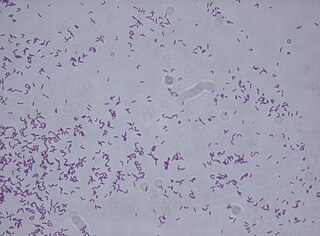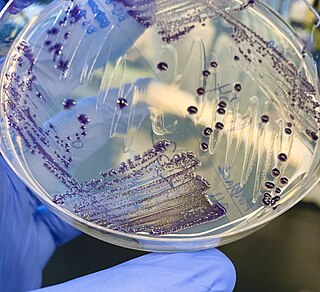Related Research Articles
Methylotrophs are a diverse group of microorganisms that can use reduced one-carbon compounds, such as methanol or methane, as the carbon source for their growth; and multi-carbon compounds that contain no carbon-carbon bonds, such as dimethyl ether and dimethylamine. This group of microorganisms also includes those capable of assimilating reduced one-carbon compounds by way of carbon dioxide using the ribulose bisphosphate pathway. These organisms should not be confused with methanogens which on the contrary produce methane as a by-product from various one-carbon compounds such as carbon dioxide. Some methylotrophs can degrade the greenhouse gas methane, and in this case they are called methanotrophs. The abundance, purity, and low price of methanol compared to commonly used sugars make methylotrophs competent organisms for production of amino acids, vitamins, recombinant proteins, single-cell proteins, co-enzymes and cytochromes.
Symbiotic bacteria are bacteria living in symbiosis with another organism or each other. For example, rhizobia living in root nodules of legumes provide nitrogen fixing activity for these plants.

Tibicos, or water kefir, is a traditional fermented drink made with water and a symbiotic culture of bacteria and yeasts (SCOBY) held in a polysaccharide biofilm matrix created by the bacteria. It is sometimes consumed as an alternative to milk-based probiotic drinks or tea-cultured products such as kombucha. Water kefir is typically made as a probiotic homebrew beverage. The finished product, if bottled, will produce a carbonated beverage.

Rhodococcus fascians is a Gram positive bacterial phytopathogen that causes leafy gall disease. R. fascians is the only phytopathogenic member of the genus Rhodococcus; its host range includes both dicotyledonous and monocotyledonous hosts. Because it commonly afflicts tobacco (Nicotiana) plants, it is an agriculturally significant pathogen.
Methylorubrum extorquens is a Gram-negative bacterium. Methylorubrum species often appear pink, and are classified as pink-pigmented facultative methylotrophs, or PPFMs. The wild type has been known to use both methane and multiple carbon compounds as energy sources. Specifically, M. extorquens has been observed to use primarily methanol and C1 compounds as substrates in their energy cycles. It has been also observed that use lanthanides as a cofactor to increase its methanol dehydrogenase activity
Methylobacillus flagellatus is a species of aerobic bacteria.

The genus Massilia belongs to the family Oxalobacteriaceae, and describes a group of gram-negative, motile, rod-shaped cells. They may contain either peritrichous or polar flagella. This genus was first described in 1998, after the type species, Massilia timonae, was isolated from the blood of an immunocompromised patient. The genus was named after the old Greek and Roman name for the city of Marseille, France, where the organism was first isolated. The Massilia genus is a diverse group that resides in many different environments, has many heterotrophic means of gathering energy, and is commonly found in association with plants.
Methylorubrum populi is an aerobic, pink-pigmented, facultatively methylotrophic, methane-utilizing bacterium isolated from poplar trees. Its type strain is BJ001T.

The root microbiome is the dynamic community of microorganisms associated with plant roots. Because they are rich in a variety of carbon compounds, plant roots provide unique environments for a diverse assemblage of soil microorganisms, including bacteria, fungi, and archaea. The microbial communities inside the root and in the rhizosphere are distinct from each other, and from the microbial communities of bulk soil, although there is some overlap in species composition.
Methylobacterium gossipiicola is a Gram-negative, aerobic, facultatively methylotrophic bacteria from the genus of Methylobacterium which has been isolated from cotton in Coimbatore in India.
Methylobacterium marchantiae is a facultatively methylotrophic facultative methylotrophy bacteria from the genus of Methylobacterium which has been isolated from the moos Marchantia polymorpha in Bergpark Wilhelmshöhe near Kassel in Germany.
Methylobacterium oryzae is a facultatively methylotrophic and aerobic bacteria from the genus of Methylobacterium which has been isolated from tissues of the rice plant Oryza sativa in Cheongwon in Korea. Methylobacterium oryzae can utilize 1-aminocyclopropane 1-carboxylate. Methylobacterium oryzae can promote plant growth.
Methylobacterium persicinum is a facultatively methylotrophic and aerobic bacteria from the genus of Methylobacterium which has been isolated from the rice plant Oryza sativa in Iksan in Korea.
Methylorubrum thiocyanatum is a facultative methylotroph bacteria from the genus Methylorubrum that has been isolated from soil around the plant Allium aflatunense in Warwickshire, United Kingdom.
Methylobacterium thuringiense is a Gram-negative, aerobic, facultatively methylotrophic and rod-shaped bacteria from the genus of Methylobacterium.
Methylobacterium trifolii is a Gram-negative, aerobic, facultatively methylotrophic and rod-shaped bacteria from the genus of Methylobacterium.
A phytobiome consists of a plant (phyto) situated in its specific ecological area (biome), including its environment and the associated communities of organisms which inhabit it. These organisms include all macro- and micro-organisms living in, on, or around the plant including bacteria, archaea, fungi, protists, insects, animals, and other plants. The environment includes the soil, air, and climate. Examples of ecological areas are fields, rangelands, forests. Knowledge of the interactions within a phytobiome can be used to create tools for agriculture, crop management, increased health, preservation, productivity, and sustainability of cropping and forest systems.
Methylorubrum pseudosasae is a Gram-negative, aerobic, facultatively methylotrophic bacteria from the genus Methylorubrum which has been isolated from bamboo leaves.
Plant root exudates are fluids emitted through the roots of plants. These secretions influence the rhizosphere around the roots to inhibit harmful microbes and promote the growth of self and kin plants.

The plant microbiome, also known as the phytomicrobiome, plays roles in plant health and productivity and has received significant attention in recent years. The microbiome has been defined as "a characteristic microbial community occupying a reasonably well-defined habitat which has distinct physio-chemical properties. The term thus not only refers to the microorganisms involved but also encompasses their theatre of activity".
References
- ↑ Omer ZS, Tombolini R, Gerhardson B (March 2004). "Plant colonization by pink-pigmented facultative methylotrophic bacteria (PPFMs)". FEMS Microbiology Ecology. 47 (3): 319–26. Bibcode:2004FEMME..47..319O. doi: 10.1016/S0168-6496(04)00003-0 . PMID 19712320.
- ↑ Green PN (2001). "Methylobacterium". In Dworkin M (ed.). The Prokaryotes: An Evolving Electronic Resource for the Microbiological Community (3rd, release 3.7 ed.). New York: Springer-Verlag.
- 1 2 3 Kutschera U (March 2007). "Plant-associated methylobacteria as co-evolved phytosymbionts: a hypothesis". Plant Signaling & Behavior. 2 (2): 74–8. doi:10.4161/psb.2.2.4073. PMC 2633902 . PMID 19516971.
- ↑ Balachandar D, Raja P, Sundaram S (January 2008). "Genetic and metabolic diversity of pink-pigmented facultative methylotrophs in phyllosphere of tropical plants". Brazilian Journal of Microbiology. 39 (1): 68–73. doi:10.1590/s1517-83822008000100017. PMC 3768351 . PMID 24031182.
- 1 2 3 4 Holland MA (April 2016). "Probiotics for Plants? What the PPFMs told us and some ideas about how to use them". Journal of the Washington Academy of Sciences. Washington Academy of Sciences. 102 (1): 31. ProQuest 1835329526.
- ↑ Koenig RL, Morris RO, Polacco JC (April 2002). "tRNA is the source of low-level trans-zeatin production in Methylobacterium spp". Journal of Bacteriology. 184 (7): 1832–42. doi:10.1128/JB.184.7.1832-1842.2002. PMC 134930 . PMID 11889088.
- ↑ Madhaiyan M, Poonguzhali S, Senthilkumar M, Seshadri S, Chung H, Jinchul YA, Sundaram S, Tongmin SA (October 2004). "Growth promotion and induction of systemic resistance in rice cultivar Co-47 (Oryza sativa L.) by Methylobacterium spp. Botanical". Bulletin of Academia Sinica: 45.
- ↑ Doronina NV, Ivanova EG, Trotsenko I (2002). "[New evidence for the ability of methylobacteria and methanotrophs to synthesize auxins]". Mikrobiologiia (in Russian). 71 (1): 130–2. PMID 11910802.
- ↑ Siddikee M, Hamayun M, Han GH, Sa TM (2010). "Optimization of gibberellic acid production by Methylobacterium oryzae CBMB20". Korean Journal of Soil Science and Fertilizer. 43 (4): 522–7.